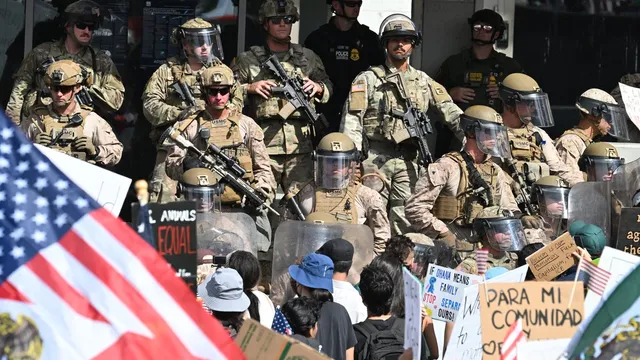
Trump deploys National Guard amid escalating protests in Los Angeles
2025-06-20 03:52- Los Angeles experienced violent protests and riots following immigration raids against undocumented individuals.
- Donald Trump sent in 2,000 National Guard members and Marines, citing the need for federal intervention amid escalating violence.
- The actions faced criticism from local leaders and a significant portion of the public, leading to rising disapproval of Trump's immigration handling.
Express your sentiment!
Insights
In the United States, Los Angeles has seen significant unrest since June 6, 2025, following immigration raids aimed at apprehending undocumented immigrants. The situation escalated as protests turned violent, with demonstrators committing acts such as setting vehicles on fire and attacking federal law enforcement officers with heavy objects. These protests were a direct response to President Donald Trump's immigration policies, prompting him to deploy a mix of 2,000 National Guard members and U.S. Marines to restore order amidst the chaos. As tensions increased, Democrats criticized Trump's use of military force, with local leaders denouncing his actions as an overreach of power. Trump's administration argued that federal law enforcement was necessary to maintain public safety, and supporters like Senator Tom Cotton echoed this sentiment, asserting that federal troops were required to protect citizens and law enforcement from what they described as violent left-wing militias. Amidst the unrest, public sentiment appeared to be shifting against Trump's handling of immigration and the protests. A recent poll indicated that disapproval of his immigration policy was rising, with 54% of registered voters expressing dissatisfaction with his approach. Moreover, a significant portion of the public opposed the deployment of National Guard troops, with many believing the local police could manage the situation without federal intervention. This increase in disapproval signals that while Trump aims to bolster his position on immigration, the aggressive tactics may come with political risks. Legal challenges also arose, with California’s governor, Gavin Newsom, launching a lawsuit against the federal government for deploying the National Guard without state approval. A U.S. district judge ruled in favor of Newsom, ordering the National Guard's return to state control. As the situation develops, the ramifications of this deployment may have lasting impacts on local governance, federal authority, and the ongoing broader national discourse regarding immigration and civil unrest.
Contexts
The history of protests in Los Angeles is a vibrant tapestry woven with threads of social change, civil rights, and community activism. Dating back to the early 20th century, Los Angeles has been a focal point for various movements seeking to address issues like labor rights, racial equality, and police accountability. One notable early instance was the 1919 Eastside Los Angeles labor strike, which highlighted the struggles of immigrant laborers and set a precedent for future activism. The Civil Rights Movement of the 1960s, fueled by the desire for racial equity, saw significant protests in the city, including the famous 1965 Watts riots, a response to systemic racism and police brutality that underscored the socioeconomic divides in Los Angeles. This pivotal event not only shaped public consciousness but also prompted a wave of reforms aimed at addressing the grievances of the African American community. As the decades progressed, protests in Los Angeles evolved to encompass a broader range of issues, including anti-war sentiments during the Vietnam War, environmental concerns, and immigrant rights. The 1980s and 1990s saw the rise of movements advocating for Latinx rights, notably during the 1986 Immigration Reform and Control Act protests, which galvanized the Latino community in the fight against discrimination and for fair immigration policies. The Rodney King incident in 1991 reignited outrage against police brutality, culminating in the 1992 Los Angeles riots following the acquittal of officers involved in King's brutal beating. This event starkly illustrated the racial tensions and economic inequalities prevailing in the city, leading to calls for systemic police reform and social justice. Entering the 21st century, Los Angeles has continued to be a hotbed for protests, responding to a variety of issues such as climate crisis, housing affordability, and racial justice. The 2006 immigrant rights protests, which brought millions to the streets in support of undocumented immigrants, were among the largest demonstrations in U.S. history. These gatherings underscored the city's diverse demographic and the vital role of immigrant communities in shaping Los Angeles' identity. The Black Lives Matter movement gained significant momentum in the wake of national incidents of police violence, particularly in 2014, drawing thousands to the streets of Los Angeles and demanding accountability and reform from law enforcement. Today, Los Angeles remains a city where protests serve as a powerful tool for civic engagement and social change. Recent movements addressing climate change, economic inequality, and systemic racism continue to mobilize citizens from various backgrounds, reflecting a commitment to activism entrenched in the city's history. Protests in Los Angeles symbolize resilience and the ongoing struggle for a more just society, adapting to the changing societal landscape while remaining rooted in the city’s rich legacy of advocacy. The lessons learned from previous protests shape the narrative of contemporary movements, ensuring that the voices of marginalized communities remain at the forefront as they advocate for transformative change in their city.